Original URL: https://www.theregister.com/2008/11/18/review_graphics_card_sapphire_radeon_hd_4850_x2/
Sapphire Radeon HD 4850 X2 dual-GPU graphics card
One card, two very fast graphics chips
Posted in Personal Tech, 18th November 2008 13:02 GMT
Review The thinking behind the ATI Radeon HD 4870 X2 seems quite clear. One 4870 and a bunch of GDDR 5 is the basis for a decent graphics card that costs £200-240 but lacks the grunt to take on the GeForce GTX 280. Join two 4870s together on a single card and you have the "fastest gaming graphics card in the world", allegedly.
As an added bonus the £399 price is marginally cheaper than buying two individual 4870s.
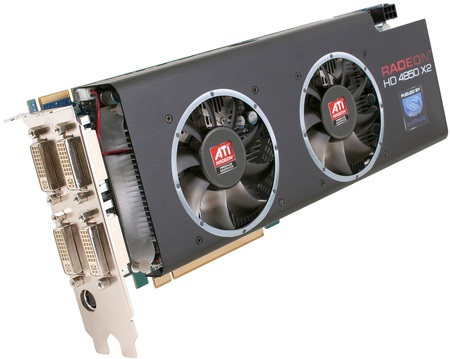
Sapphire's HD 4850 X2: four DVI-I ports, anyone?
The Radeon HD 4850 X2 follows the same blueprint by joining two 4850s on a single graphics card, but it’s a different proposition. The 4870 X2 was manufactured by AMD and marketed by its partners, while the 4850 X2 is made by the partners themselves. To date, this Sapphire card is the only 4850 X2 we’ve seen and we suspect that the strength of the dollar will kill off plans by some other companies to follow it.
The problem is that a 4850 X2 with 1GB of DDR 3 will sell for the equivalent of $369. The 2GB version is $419. In a sane and righteous world, we’d be looking at UK prices of £219 and £249, respectively, that compare quite favourably with a 1GB 4850 at £135 and a 2GB model at £165. Unfortunately, however, you can expect the two Sapphires to go on sale at £270 and £317, which is the same price as two individual 4850 cards.
There's a superficial similarity between the Sapphire 4850 X2, AMD's 4870 X2 and Nvidia's GeForce GTX 280: all three cards are double-slot designs that are very long. The 4870 X2 and GTX 280 measure 267mm in length, while the Sapphire is a tad longer, at 285mm. The Sapphire design department has clearly been hard at work, and while the 4870 X2 has a humongous weight of 1218g the Sapphire comes in at a sprightly 764g. To put that in context the GeForce GTX 280 weighs 908g.
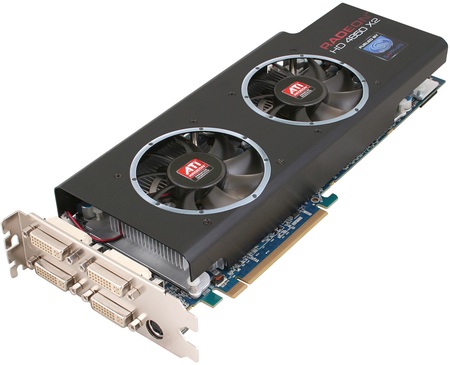
Two fans make card light
The GTX 280 and 4870 X2 each use a single cylindrical 70mm fan that blows air the length of the card until the hot air exhausts through the vented bracket. In the case of the 4870 X2, the heatsink is a slab of copper, which explains the weight of the card, but Sapphire has chosen to install an aluminium heatsink on each of the 4850 GPUs, with a pair of 75mm fans to keep everything cool. They are the sort of coolers that you use on a CPU. The heat exhausts inside the PC case, so you may well need to consider some additional case cooling as the Sapphire draws 165W in Windows and 280W during a gaming session.
The black shroud you see in the photos is a piece of curved aluminium that pretties up the card and helps to keep cables out of the fans.
This choice of cooling system has allowed Sapphire to fit four DVI-I connectors to the bracket - overkill for most of us but it will doubtless fill some people with joy. The Sapphire package includes a DVI-to-HDMI adaptor, a DVI-to-VGA adaptor, a composite-video adaptor and a component-video adapter.
In addition there is a decent collection of CyberLink software, consisting of PowerDVD 7 and CyberLink DVD Suite, which is made up of PowerProducer 4, PowerDirector 5 Express, Power2GO 5.5 and Medi@show 3.
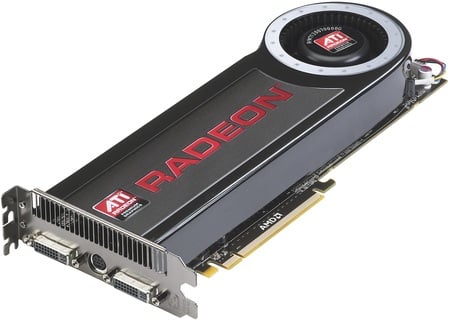
AMD's ATI Radeon HD 4870 X2: scarily high power draw
We tested the Sapphire back-to-back with a reference 4870 X2 that sells for £399 and a reference GTX 280 that is typically available for £330. We used the Asus P6T Deluxe motherboard with Intel i7 965 Extreme 'Nehalem' CPU and 3GB of 1066MHz of DDR 3 with Windows Vista Ultimate Edition.
We tested the GeForce GTX 280 with Nvidia’s latest 180.44 beta driver, which boosts the card in 3DMark Vantage by offloading the PhysX workload from the CPU to the GPU. This raises the score for the CPU element of the test by a huge amount which, in turn, raises the overall score and appears to give the GTX 280 the same performance as the overclocked 4850 X2.
You’ll probably get a more accurate impression of the GTX 280 if you look at the GPU results in 3DMark Vantage or instead look at 3DMark06 where you can see that performance drops off sharply when anti-aliasing is added to the workload.
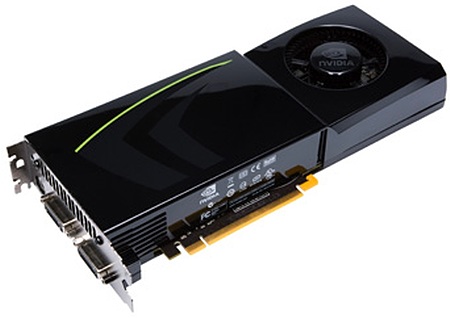
Nvidia's GeForce GTX 280: impressive power-saving features
Benchmark runs in Far Cry 2 show the GTX 280 in a very good light, due at least in part to this being an Nvidia-sponsored game but also because it's a darn fine graphics card. The performance figures can be interpreted in a number of ways, but there's no denying that the power-saving features of GTX 280 are very impressive. It only has a power draw of 135W in Windows, when it is practically silent, and draws 280W when the system was running at full pelt.
3DMark Vantage Results
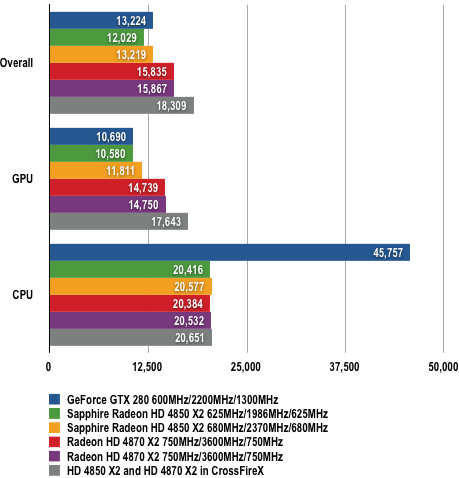
Longer bars are better
Nb. the two 4870 X2 scores use, respectively, the Catalyst 8.551.1.71310 and 8.11 drivers
3DMark06 Results
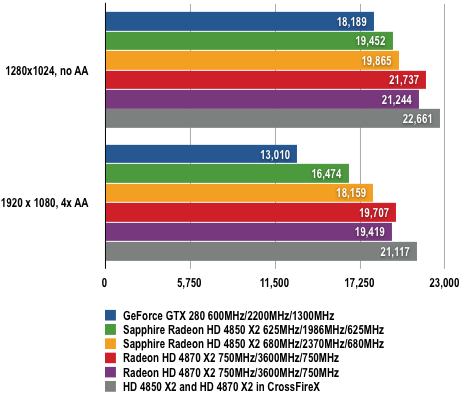
Longer bars are better
Far Cry 2 Results
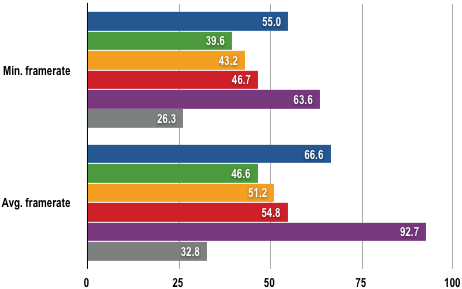
1280 x 1024 at Very High Quality
DirectX 9
Nb. the two 4870 X2 scores use, respectively, the Catalyst 8.551.1.71310 and 8.11 drivers
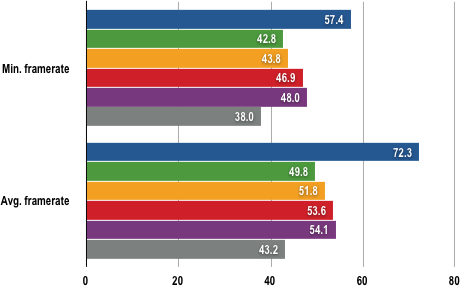
1280 x 1024 at Very High Quality
DirectX 10
Nb. the two 4870 X2 scores use, respectively, the Catalyst 8.551.1.71310 and 8.11 drivers
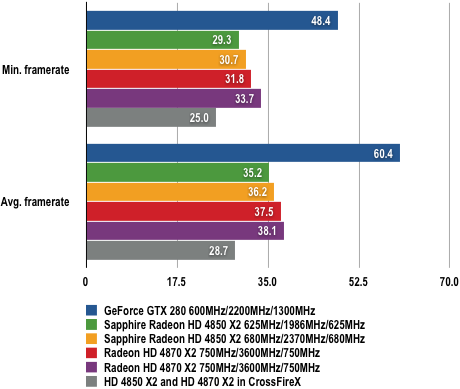
1920 x 1080 at Very High Quality
DirectX 10
Nb. the two 4870 X2 scores use, respectively, the Catalyst 8.551.1.71310 and 8.11 drivers
Moving on, the Sapphire 4850 X2 has a core speed of 625MHz with an effective memory speed of 1986MHz. It zipped through all the tests and compared very favourably with the GTX 280 in 3DMark and less well in Far Cry 2. We had the quality settings in Far Cry 2 set to Very High, which is a stern test but the 4850 X2 pulled through. The power draw was higher than GTX 280 in Windows at 165W but under load the figure was the same.
Power Draw Results
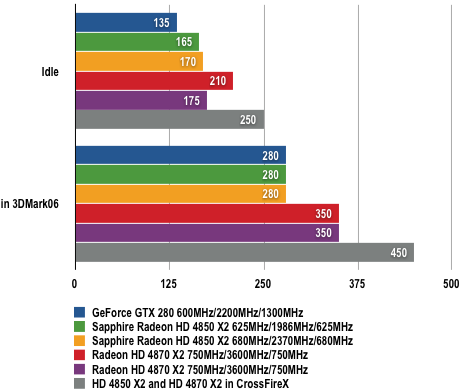
Power draw in Watts
Nb. the two 4870 X2 scores use, respectively, the Catalyst 8.551.1.71310 and 8.11 drivers
We used the Catalyst 8.551.1.71310 driver to overclock the Sapphire to a core speed of 680MHz and memory speed of 2370MHz. This raised performance by ten per cent in 3DMark and Far Cry on DirectX 9 although this advantage dropped to a mere one frame per second in Far Cry 2 when we used DirectX 10.
The 4870 X2 uses the same technology as the 4850 X2 except that the core speed is higher - 750MHz - and the effective memory speed is a colossal 3600MHz due to the nature of GDDR 5 memory. This extra speed delivered 20-30 percent more performance in 3DMark compared to 4850 X2, and in Far Cry 2 the 4870 X2 delivered a few extra frames per second over 4850 X2. The power draw of the 4870 X2 is scarily high: 210W in Windows and 350W under load.
Just for larks, we hooked up the 4850 X2 and 4870 X2 in CrossFireX which cranked up 3DMark performance by a small amount. However, it clobbered performance in Far Cry 2, which pretty much sums up our experiences with CrossFire over the years.
The Sapphire HD 4850 X2 was horribly noisy because the drivers were only controlling one fan while the other fan roared away at full speed. Sapphire tells us that it will be releasing an updated Bios that will fix the noise issue in conjunction with a revised driver.
Verdict
The Sapphire HD 4850 X2 delivers the same performance as a single GTX 280 but unfortunately the horrendous dollar exchange rate means that they also cost the same. And that makes the Sapphire look far too complicated when it is compared to the Nvidia alternative.